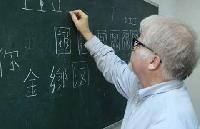Expat consumes life in Chinese tea
In 2006, Peltier finally arrived in Fujian province, an area known for its tea culture.
He worked in Longyan city as an English teacher, and was thrilled when he discovered a tea shop on almost every street corner.
"I dropped by a shop to sit and drink, and the tea they sold turned out to be Tieguanyin, which is floral and fresh," Peltier says.
"Later I bought a tea set in my house and made brewing, drinking and researching my daily routine," Peltier says.
A year later, Peltier moved to Fu-zhou, the provincial capital, with his wife, a Fuzhou native whom he met in Longyan.
Still working as an English teacher, Peltier continued to research tea in Fuzhou and was pleased to discover the city's trademark export, jasmine tea.
After a lot of research and gathering about 50 ancient tea monographs, Peltier began writing his own tea book in 2008.
His plan was to sort through his gathered material and combine it into a book centered on the technique and taste of tea practiced in ancient China.
During the editing process, he was struck by some interesting information. He was particularly taken with a technique in the Song Dynasty (960-1279) called "parting tea" in which tea brewers whisked the tea to create amazing images such as flowers and birds in the foam on the top of the broth.


















